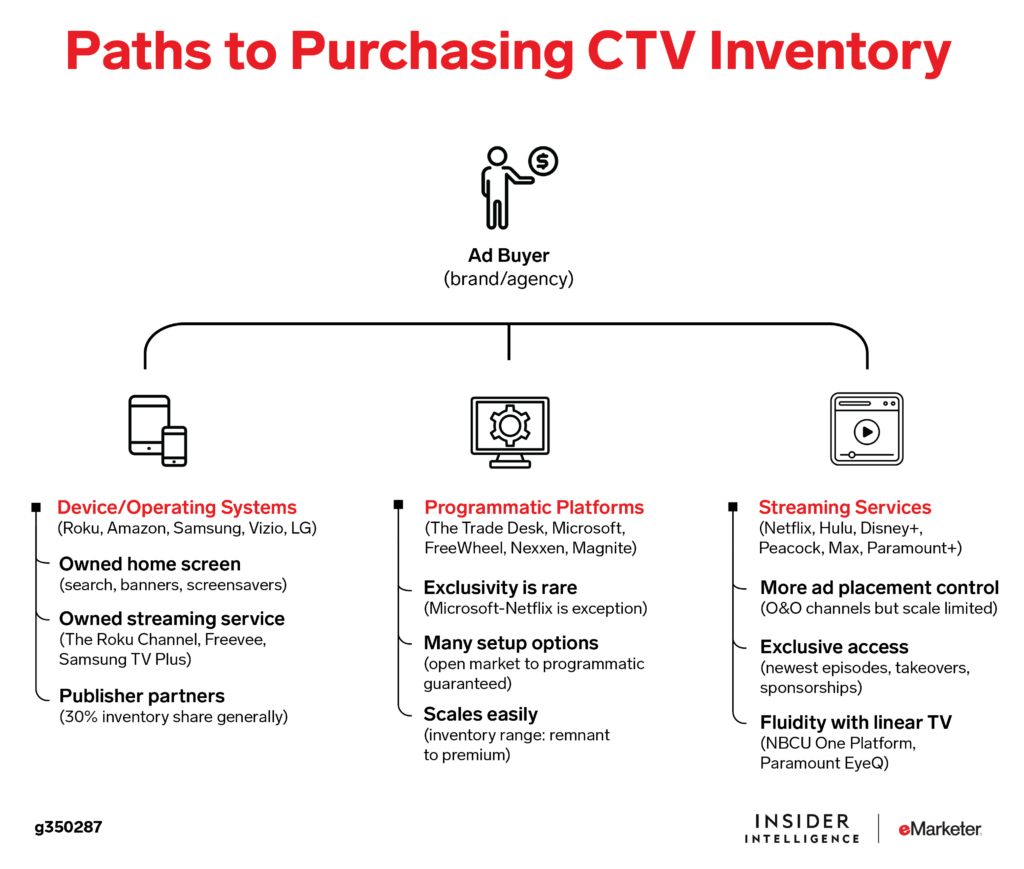Connected TV or CTV advertising stands out as a transformative force, bridging the gap between traditional television and modern streaming platforms. As consumers increasingly shift towards connected TV experiences, brands are recognizing the unparalleled potential of CTV advertising to deliver personalized, engaging content directly to their target audience. This evolution not only reshapes the advertising landscape but also offers innovative opportunities for brands to connect, engage, and convert viewers like never before.
We’d like to acknowledge the insightful article from eMarketer, titled “3 Burning CTV Questions Answered by Our Analyst”, which provided valuable data and perspectives. The insights from this piece have been instrumental in shaping and enriching the content of our article.
The Current Landscape of CTV Advertising
Technology is moving faster today than it was yesterday and Connected TV (CTV) advertising is reshaping how brands interact with their audience. But as with all things new, it’s still finding its feet, evolving, and revealing its full potential.
One of the most telling indicators of this nascent stage is the ad tier structure on platforms like Netflix, Disney+, and Max. These platforms, which command a significant chunk of viewership globally, have only recently started to dabble in advertising. The introduction of ad tiers is a clear acknowledgment of the growing influence and viability of CTV advertising. But it’s also a reminder that we’re just at the tip of the iceberg.
Consider this: Between 2021 and 2023, CTV’s share in the total TV ad inventory was only between 15% to 23%. Given the increasing adoption rates of streaming services, this number is bound to rise. The gradual shift of viewers from traditional cable TV to streaming platforms is evident. Yet, the ad inventory on CTV platforms is not proportionate to its viewership, signifying a vast untapped potential.
To put it succinctly, CTV advertising is not the future; it’s the present. And brands that recognize this shift early will be the ones leading the charge in the next wave of digital advertising.

The Declining Reign of Traditional TV
For decades, traditional TV held an unrivaled position in our living rooms. From evening news to weekend movies, it played an integral role in family bonding and cultural exchange. But as with all things, change is the only constant, and the reign of cable and broadcast TV is experiencing a noticeable shift.
The numbers are hard to ignore. Recent data indicates that the share of time spent by US adults on cable and broadcast TV has dipped to just 49.6%. This decline isn’t a sudden phenomenon but a result of evolving viewer habits, technological advancements, and the surge of on-demand content platforms.
Streaming services offer a buffet of content choices, allowing viewers to decide what to watch and when. No longer are audiences tethered to TV schedules or willing to sit through repetitive commercials. Think about your own viewing habits now compared to even 5 years ago. Do you demand flexibility, variety, and a more personalized viewing experience? That’s what streaming platforms readily provide.
This decrease in traditional TV viewership isn’t just a statistic; it’s a sign of changing times. It signals a shift in power from broadcasters to viewers, who now possess more control over their entertainment choices. For advertisers, this presents both challenges and opportunities. The challenge lies in reaching an audience that’s fragmented across multiple platforms. The opportunity? To engage a more targeted, attentive viewer base on platforms where they spend significant time.
For brands and advertisers, it’s crucial to understand this shift. Holding on to age-old advertising strategies on declining mediums is akin to swimming against the tide. Embracing the change, on the other hand, paves the way to connect with audiences in more meaningful, impactful ways.
Why We’re Bullish on CTV Advertising
The digital advertising landscape has been in a state of constant flux, with new platforms and strategies emerging continually. Among these, CTV advertising stands out, not as a fleeting trend, but as a powerhouse poised to revolutionize the way brands connect with their audience. And here’s why we’re not just optimistic but downright bullish about it.
Firstly, let’s talk inventory. The sheer range of inventory and the granularity of inventory segmentation CTV offers are unmatched. Consider platforms like MNTN. Ever thought of running your ads exclusively for a “Shark Tank” audience? With CTV, such precision is not just possible; it’s effortlessly achievable. Such targeted outreach means your ads aren’t merely being viewed—they’re being engaged with by an audience that’s genuinely interested.
Yet, the world of CTV isn’t without its challenges. Digital marketing has wrestled with attribution concerns for years. And CTV introduces its own set of complexities. A viewer might come across a CTV ad, browse the product on their mobile, and eventually make a purchase on their laptop. Amidst all these touchpoints, they might also engage with social media promotions or click on a remarketing ad. So, in this intricate web, who gets the credit? Where should brands pump in more dollars?

The Complex World of Digital Attribution
The allure of digital marketing has always been its promise of measurability. Brands, for the first time, could see where their dollars were going and gauge the impact. Yet, as the landscape expanded, so did the challenges, with attribution being one of the most formidable ones.
Today, less than half of all marketing professionals worldwide feel truly confident in measuring the ROI for CTV and OTT advertising. And it’s understandable why. The customer journey has become far more intricate than a simple click and purchase. Let’s break it down.
Picture this: A viewer encounters an ad on their CTV. Intrigued, they pull up the website on their smartphone. A few hours later, they read reviews, engage with the brand on social media, and maybe click on a retargeting ad from platforms like META. Eventually, they complete the transaction on their laptop. Now, in this multi-device, multi-platform journey, which touchpoint gets the credit?
Digital marketing has grappled with such attribution questions for years. But CTV adds a new layer to this puzzle. The cross-device actions within a single household, coupled with the myriad of channels a consumer interacts with, make attribution a complex endeavor.
However, it’s not all doom and gloom. Solutions are emerging, and innovation is at the forefront. For instance, using compelling calls to action, vanity URLs (like “https://yourbrand.com/tvoffer”), or scannable QR codes can provide better tracking. Platforms like MNTN are also stepping up, offering real-time attribution built specifically for TV, distinguishing CTV-driven traffic from other sources.
In essence, while the attribution maze is intricate, it’s not impassable. With the right tools, strategies, and a touch of creativity, brands can navigate this landscape, ensuring that their CTV advertising efforts are not just impactful but also measurable.
Case Studies: Hulu vs. MNTN
In the world of CTV advertising, theory and speculation only go so far. What truly matters is on-the-ground experience, tangible results, and lessons learned from real campaigns. Let’s dive into our hands-on experiences with two significant players in the CTV arena: Hulu and MNTN.
Hulu Ads: A giant in the streaming space, Hulu offers a vast audience base. While advertising on this platform guarantees reach, there’s a catch. The insights provided by Hulu are somewhat limited, mainly focusing on deliverability. But that doesn’t mean advertisers are in the dark.
To gain deeper insights into campaign performance, we’ve implemented strategies like specific calls to action, vanity URLs (e.g., “https://yourbrand.com/tvoffer”), and QR codes. These tools not only help in better tracking but also enhance user engagement, allowing viewers to interact directly with the ad, bridging the gap between viewing and action.
MNTN: A platform that’s carving a niche for itself, MNTN offers something invaluable: advanced attribution tracking. Their system, dubbed “Real Time Attribution Built for TV,” is a game-changer. MNTN goes beyond mere deliverability stats. They authenticate visits across connected devices, filtering out traffic from other marketing channels. This integrated approach is connected to brands’ Google Analytics accounts, offering a comprehensive view of traffic and conversions.
Our campaigns on MNTN, especially when blending prospecting with retargeting, have shown a noticeable uptick in cross-channel traffic. This data is gold, shedding light on the incremental value CTV campaigns bring to the table.
Drawing from these experiences, a crucial lesson emerges: CTV advertising is not just about choosing the right platform but also about harnessing the unique features and tools each platform offers. By understanding and leveraging these nuances, advertisers can maximize the impact of their campaigns, driving not just views, but meaningful engagements and conversions.
Getting Started with CTV and Unlocking its Potential
For high-ticket service businesses and affluent e-commerce brands, the digital frontier offers a plethora of opportunities, and CTV is the latest gold rush. While many are familiar with digital marketing’s broader strokes, the specifics of CTV can be a tad elusive. But fear not, for the journey into CTV, while new, is built on the foundations of traditional digital marketing.
Understanding the Medium:
CTV isn’t merely another channel to broadcast your ads. It’s an interactive platform that marries the immersive experience of television with the personalization of digital marketing. The key is to approach it not as a standalone medium but as an integral part of a holistic digital strategy.
Harnessing its Strengths:
Platforms like MNTN have showcased that CTV’s true strength lies in its precision. Want to target the “Shark Tank” audience exclusively? It’s possible. Such granular targeting ensures that your ads resonate, leading to higher engagement and conversion rates.
Innovating Around its Limitations:
Yes, CTV has its challenges, especially around attribution. But as our experiences with Hulu and MNTN have shown, these challenges are surmountable. With the right strategies — from unique calls to action to advanced attribution tracking — brands can glean actionable insights from their campaigns.
The Road Ahead:
The world of CTV is evolving, and early adopters stand to gain the most. As with all digital channels, the landscape will mature, best practices will emerge, and platforms will offer enhanced features. But the brands that start now, experiment, and iterate will be the ones that truly harness CTV’s potential.
Branching out into CTV advertising might feel like uncharted territory, but with the right mindset and strategies, it’s ripe with opportunities. And for brands looking to make a mark, there’s no better time to embark on the CTV journey than now.






